When I plot data sampled per month with bars, their width is very thin. If I set X axis minor locator to DayLocator(), I can see the bars width is adjusted to 1 day, but I would like them to fill a whole month.
I tried to set the minor ticks locator to MonthLocator() without effect.
[edit]
Maybe an example will be more explicit, here is an ipython -pylab example of what I mean :
x = [datetime.datetime(2008, 1, 1, 0, 0),
datetime.datetime(2008, 2, 1, 0, 0),
datetime.datetime(2008, 3, 1, 0, 0),
datetime.datetime(2008, 4, 1, 0, 0),
datetime.datetime(2008, 5, 1, 0, 0),
datetime.datetime(2008, 6, 1, 0, 0),
datetime.datetime(2008, 7, 1, 0, 0),
datetime.datetime(2008, 8, 1, 0, 0),
datetime.datetime(2008, 9, 1, 0, 0),
datetime.datetime(2008, 10, 1, 0, 0),
datetime.datetime(2008, 11, 1, 0, 0),
datetime.datetime(2008, 12, 1, 0, 0)]
y = cos(numpy.arange(12) * 2)
bar(x, y)
This gives 12 2 pixels wide bars, I would like them to be wider and extend from month to month.
